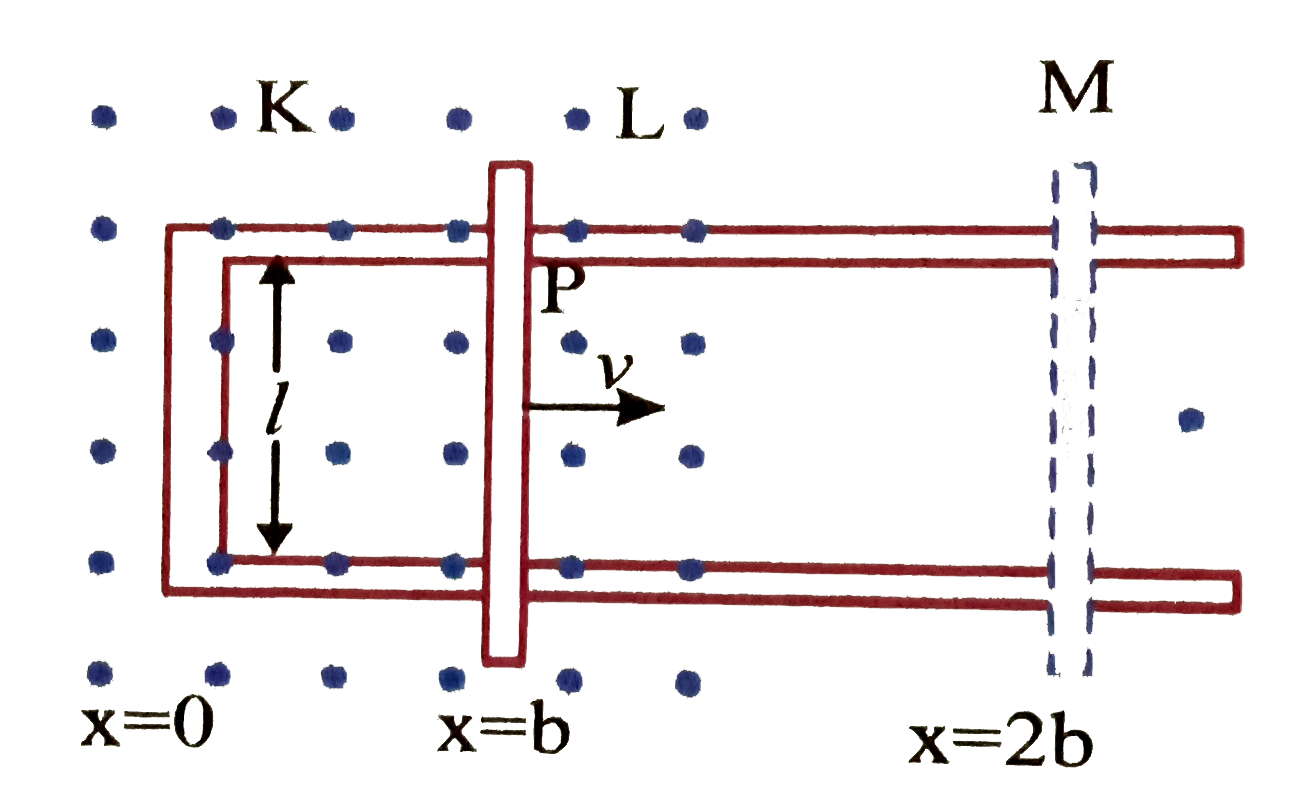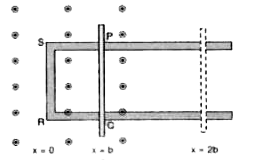Refer to figure the arm PQ of the rectangular conductor is moved from x = 0, outwards. The uniform magnetic field is perpendicular to the plane and extends from x = 0 to x = b and is zero for x > b. Only the arm PQ possesses substantial resistance r. Consider the situation when the arm PQ is pulled outwards from x = 0 to x = 2b and is then moved back to x = 0 with constant speed v. Obtain expressions for the flux, the induced emf, the force necessary to pull the arm and the power dissipated as Joule heat. Sketch the variation of these quantities with distance.
 Solution in Gujrati
Solution in Gujrati
Part I: When slider arm PQ moves towards right from x = 0 to x = b and then from x = b to x = 2b with constant speed v,

Here points R and S are fixed points whereas points P and Q keep on sliding from S to P. and from R to Q. as slider arm changes its position from x = 0 to x = 2b. Required quantities can be found out as follows:
(i)Magnetic flux :
ϕ=Blx (From x =0 to x=b)
ϕ=Blb (From x =b to x = 2b)
Here, from x=0 to x=b , ϕ increases linearly with x whereas from x=b to x=2b, ϕ remains constant ) ...(1)
(ii)induced emf :
From x=0 to x=b,
ϕ=Blx=Bl(vt)
∴ε=−dϕdt=-Blv(1)=-Bvl =constant
From x=b to x=2b,
ε=0 (∵ϕ=constant)...(2)
(iii)External force to keep slider arm PQ under equilibrium :
F=IlBsin90∘=IlB=εrlB
∴F=(−Bvl)rlB=−B2l2vr (Where r= resistance of slider arm PQ) ...(3)
∴ F=constant (∵ B,l,v,r are constants)
From x=0 to x=b ,
F=−B2l2vr = constant
From x=b to x=2b,
F=−B2l2vvr=ε2vr=0(∵ε=0)...(4)
(iv) Joulean power , P=ε2r=B2v2l2r
From x=0 to x=b , P=B2v2l2r=ε2r=constant
From x=b to x=2b, P=0 (∵ε=0) ...(5)
From results (1),(2),(3),(4) and (5) graphs of ϕ,ε,F,P→x can be plotted as follows :

Part II : When slider arm moves towards left from x = 2b to x = b and then from x = b to x = 0 with constant speed v.
In this case, all of above graphs are retraced in the directions opposite to previous graphs as shown below.

Topper's Solved these Questions
- ELECTROMAGNETIC INDUCTIONBook:KUMAR PRAKASHANChapter:ELECTROMAGNETIC INDUCTIONExercise:Section B (Numerical) Numerical From Textual Exercise
Explore 17 Videos
- ELECTROMAGNETIC INDUCTIONBook:KUMAR PRAKASHANChapter:ELECTROMAGNETIC INDUCTIONExercise:Section B (Numerical) Numerical From DARPAN Based on Textbook
Explore 10 Videos
- ELECTROMAGNETIC INDUCTIONBook:KUMAR PRAKASHANChapter:ELECTROMAGNETIC INDUCTIONExercise:Section A HOTS
Explore 2 Videos
- ELECTRIC CHARGES AND FIELDS Book:KUMAR PRAKASHANChapter:ELECTRIC CHARGES AND FIELDS Exercise:SECTION D MCQS ASKED IN COMPETITIVE EXAMES (MCQS AKSED IN BOARD EXAM AND GUJCET)
Explore 14 Videos
- ELECTROMAGNETIC WAVESBook:KUMAR PRAKASHANChapter:ELECTROMAGNETIC WAVESExercise:BOARD.S QUESTION PAPER MARCH - 2020 (PART - B) SECTION - C
Explore 5 Videos
Similar Questions
Predict the direction of induced current in the situations described by the following figures (a) to (d).

View SolutionA conducting circular loop is placed in a uniform magnetic field of 0.04 T with its plane perpendicular to the field. Some how, the radius of the loop starts shrinking at a constant rate of 2 mm/s. Find the induced emf in the loop at an instant when the radius becomes 2 cm solution.
View SolutionGive the explanation of reason behind the origin of motional induced emf.
View SolutionWhen air is replaced by dielectric medium of constant K, the maximum force of attraction between two charges separated by distance d, ..........
View SolutionDetermine the current in each branch of the given network.

View SolutionThe arm PQ of the rectangular conductor is moved from x=0, outwards in the uniform magnetic field which extends from x=0 to x=b and is zero for x>b as shown. Only the arm PQ possess substantial ressitance r. Consider the situation when the arm PQ is pulled outwards from x=0 to x=2b, and is then moved back to x=0 with constant speed v. Obtain expression for the flux, the induced emf, the force necessary to pull the arm and the power dissipated as Joule heat. Sketch the variation of these quantities with distance.

View SolutionState Faraday's law of electromagnetic induction. Figure shows a rectangular conductor PQRS in which the conductor PQ is free to move in a uniform magnetic field B perpendicular to the plane of the paper.The field extends from x=0 to x=b and is zero for x gt b .Assume that only the arm PQ posses resistance r .When the arm PQ is pulled outward from x=0 with constant speed v , obtain the expressions for the flux and the induced emf. sketch the variations of these quantities with distance 0 le x le 2b .
View SolutionThe arm PQ of the rectangular conductor is moved from x=0, outwards in the uniform magnetic field which extends from x=0 to x=b and is zero for x>b as shown. Only the arm PQ possess substantial resistance r. Consider the situation when the arm PQ is pulled outwards from x=0 to x=2b, and is then moved back to x=0 with constant speed v. Obtain expression for the flux, the induced emf, the force necessary to pull the arm and the power dissipated as Joule heat. Sketch the variation of these quantities with distance.

View Solutionचित्र 6.12 (a) को देखिए आयताकार चालक की भुजा PQ को x=0 से दायीं ओर चलाया जाता है एकसमान चुंबकीय क्षेत्र तल के लंबवत है तथा x=0 से x=b तक विस्तारित है तथा x>b के लिए शून्य है | केवल भुजा PQ में ही पर्याप्त प्रतिरोध r है | उस स्थिति की कल्पना कीजिए जब भुजा PQ को x=0 से x=2b तक, बाहर की ओर खिंचा जाता है तथा पुनः स्थिर चाल v से x=0 तक वापस ले जाते है | फ्लक्स, प्रेरित विधुत वाहक बल, भुजा को खींचने के लिए आवश्यक बल तथा जूल ऊष्मा के रूप में क्षयित शक्ति के लिए व्यंजक प्राप्त कीजिए | इन राशियों में दुरी के साथ होने वाले परिवर्तन का ग्राफ भी खींचिए |

View SolutionFigure shows a rectangular loop conducting PQRS in which the arm PQ is free to move. A uniform magnetic field acts in the direction perpendicular to the plane of the loop. Arm PQ is moved with a valocity v towards the arm RS. Assuming that the arms QR, RS and SP have negligible resistances and the moving arm PQ has the resistance r, obtain the expression for (i) the current in the loop (ii) the force and (iii) the power required to move the arm PQ.
View SolutionRefer to fig. The arm PQ of the rectangular conductor is moved from x=0 outwards. The uniform magnetic field is perpendicular to the plane and extends from x=0 to x=b and is zero for x>b. Only the arm PQ possesses substantial resistance r. Consider the situation when the arm PQ is pulled outwards from x=0 to x=2b, and is then moved back x=0 with constant speed υ. Obtain expressions for the flux the induced emf, the force necessary to pull the arm and the power dissipated as Joule heat. Sketch the variation of these quantities with distance.

View Solutionचित्र को देखिए।आयताकार चालक की भुजा PQ को x = 0 से दायीं ओर चलाया जाता है। एकसमान चुंबकीय क्षेत्र तल के लंबवत है तथा x = 0 से x = b तक विस्तारित है तथा x>b के लिए शून्य है। केवल भुजा PQ में ही पर्याप्त प्रतिरोध है। उस स्थिति की कल्पना कीजिए जब भुजा PQ को x = 0 से x = 2b तक बाहर की ओर खींचा जाता है तथा पुनः स्थिर चाल सेx = 0 तक वापस ले जाते हैं। फ्लक्स, विद्युत वाहक बल, भुजा को खींचने के लिए आवश्यक बल तथा जूल ऊष्मा के रूप में क्षयित शक्ति के लिए व्यंजक प्राप्त कीजिए। इन राशियों में दूरी के साथ होने वाले परिवर्तन का ग्राफ भी खींचिए।
View SolutionIn figure, the arm PQ is moved from x = 0 "to" x = 2b with constant speed V. Consider the magnet field as shown in figure. Write (i) direction of induced current in rod (ii) polarity induced across rod.
View SolutionThe arm PQ of the rectangular conductor is moved from x=0, outwards. The uniform magnetic field is perpendicular to the plane and extends from x=0 to x=b and is zero for x>b. Only the arm. PQ possesses substantial resistance r. Consider the situation when the arm PQ is pulled outwards from x=0 to x=2b, and is then moved back to x=0 with constant speed v. Obtain expressions for the flux, the induced emf, the force necessary to pull the arm and the power dissipated as Joule heat. Sketch the variation of these quantities with distance.

View Solutionफैराडे के वैद्युतचुम्बकीय प्रेरण का नियम बताएँ। चित्र में एक आयताकार चालक PQRS दिखाया गया है जिसमें चालक PQ, पृष्ठ के तल पर लम्बवत एकसमान चुम्बकीय क्षेत्र B में चलने में स्वतन्त्र है। क्षेत्र x = 0 से x = b तक फैला है और x>b के लिए शून्य है। मान लें कि केवल भुजा PQ का ही प्रतिरोध r है। जब भुजा PQ, स्थिर वेग v से बाहर की ओर x = 0 से x = 2b तक खींच कर फिर x = 0 तक वापस लायी जाती है, तो फ्लक्स और प्रेरित विद्युत वाहक बल के लिए व्यंजक निकालें। इन राशियों दूरी के साथ परिवर्तन का चित्र बनाएँ।

View Solution

